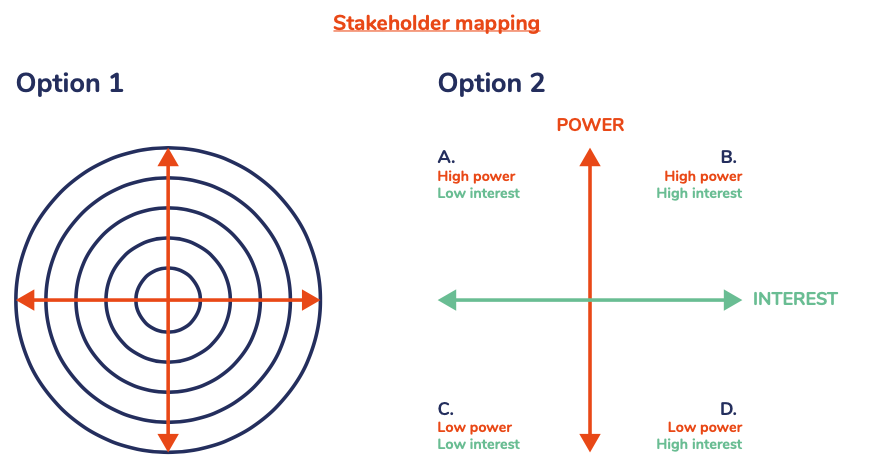Bringing in key stakeholders
Identify the key stakeholders to this project that you will want to influence or involve as early as possible. When we say stakeholders, we mean any individual, group, institution, or business that may have a significant interest in the success or failure of a project. These could be implementers, facilitators, competitors or beneficiaries. For the group to be relevant and diverse, your stakeholders should come from various sectors: community organisations, NGOs, startups, local, regional, or national government bodies. Where possible, we encourage you to bring these stakeholders together to foster a sense of shared commitment. It is important to be intentional about how you engage these groups, and agree together what role they can play throughout.
Stakeholder mapping
Identify and prioritise stakeholders to involve in the project.

HOW:
- List out who your local stakeholders are – this list can be very long
- For each stakeholder consider their interests and how they are affected by the issues, what motivations might they have for bringing about change
- Option 1: Group stakeholders by
- Their proximity to the problem
- What sector/ segment they are in
- Option 2: Group stakeholders based on
- Their level of interest – how interested and engaged are they by changes to the system?
- Their power – how much are they able to impact the system?
- Use this mapping to identify key people to engage for this work
- You can revisit it throughout the course of the project
EXAMPLE:
In Sèmè-Podji, the local group produced a written map of the local actors currently and to-be involved in their work to digitise land data and procedures. The team already had a good idea of the actors involved in the management of land data, but this process encouraged them to broaden the stakeholder group to include the startup ecosystem and the national Ministry of Technology and Digitalisation.
READ MORE: URBACT, Stakeholder Ecosystem Map
Local Action Group
Gather key local stakeholders in a group that meet regularly in order to co-produce city strategies and action plans.
HOW:
- This group should include all different stakeholders relevant to the project – keeping them close from the beginning will ensure success of the project
- Revise regularly, based on the progress of your project, the composition of the group and the skills needed in it. Some stakeholders might join in as the project advances and some might drop out as their role might no longer be relevant
- Convene regularly, involve them in key decisions and make sure they understand the direction you are taking
- Consider:
- Who should be in this group based on the stakeholder mapping you’ve done?
- How do you want them to engage with the work? Should you create an agreement for the group to hold people to account?
- How could you involve them to identify the challenge, do user research, and co-create the problem statement?
- What role might they play in identifying and implementing solutions to this problem?
- Are people participating on a voluntary basis? Do you need to cover travel allowances or other forms of cost reimbursement?
EXAMPLE:
As part of the ASToN network, the team in Niamey established a local action group which met regularly. The group included individuals from across the local authority, elected representatives, the urban transport city department, the police, local startups and the bus drivers association.
They met once a week for a few months until they understood their different roles, after which they met less frequently. The local action group worked together on some preliminary research to ensure they had a shared understanding of the issues related to mobility and the management of public transport.
READ MORE: URBACT, Local Action Group


